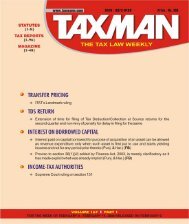news round up - Taxmann
news round up - Taxmann
news round up - Taxmann
- TAGS
- news
- round
- taxmann
- taxmann.com
Create successful ePaper yourself
Turn your PDF publications into a flip-book with our unique Google optimized e-Paper software.
132 GOODS & SERVICES TAX - MAGAZINE [Vol. 1<br />
ensure uniformity in charging of CGST and SGST, thereby ensuring<br />
no cascading effect of taxes. As per the said paper, it is being proposed<br />
that the tax base for the SGST as well as the CGST would be common,<br />
thereby safeguarding itself from any possibility of double taxation<br />
and cascading effect of taxes. It is felt that this initiative would be a<br />
major move which would apart from taking into account the aspects<br />
of practical and administrative feasibility would also go a long way<br />
in addressing the problem of double taxation as well as cascading<br />
effect of taxes.<br />
(iii) Input tax credit - As per the proposed GST model, the chain for CGST<br />
as well as the SGST has been completely keep independent of each<br />
other implying that a dealer/manufacturer would not be able to<br />
utilise the credit on either of the above taxes for payment of GST on<br />
each other except for their respective chain. Each individual chain<br />
e.g., SGST would be a consolidated levy integrating all the State level<br />
levies, thereby allowing availment as well as utilisation of input tax<br />
credit within the same chain. However, the option of cross-credit has<br />
been kept open under the Integrated Goods and Service Tax (IGST),<br />
which is applicable on Inter-State sale of goods. This concept of input<br />
tax credit is also projected to have a considerable impact in the cases<br />
of zero-rated exports/special economic zones and it still remains<br />
unclear as to whether the GST regime would convert the existing<br />
system of allowing excise rebate or removal under the UTI/bond, as<br />
in the above cases, to a completely new system.<br />
(iv) Inter-State Trade of goods and services - An integrated GST model<br />
(IGST) for taxation of inter-State sale of goods and services has been<br />
proposed in the said paper. This system of taxation is being adopted<br />
on the behest of the Central Sales Tax (CST) which would be<br />
completely phased out before adopting this new system. As per this<br />
model, the Centre would levy IGST (which is determinable as the<br />
sum total of CGST and SGST separately) in the following manner—<br />
(a) at the outset the inter-State seller would make the payment of<br />
IGST either through payment or adjustment of available credit<br />
of IGST.<br />
(b) the exporting State will transfer the IGST to the Centre out of<br />
which the SGST component would be further transferred to<br />
the importing State.<br />
(c) meanwhile, the relevant information would be submitted to the<br />
Central agency which would act as a clearing house mechanism,<br />
verify claims and inform the respective Governments to<br />
transfer the funds.<br />
(d) there would be appropriate mechanism put in place for consignment/stock<br />
transfer of goods and services.<br />
GOODS & SERVICES TAX CASES ❑ JANUARY 20 - FEBRUARY 4, 2010 ◆ 42











![“FORM NO. 3CEB [See rule 10E] Report from an ... - Taxmann](https://img.yumpu.com/45480232/1/190x245/form-no-3ceb-see-rule-10e-report-from-an-taxmann.jpg?quality=85)





